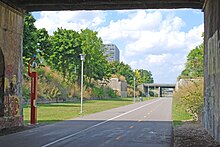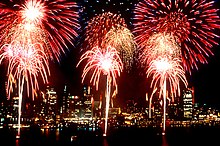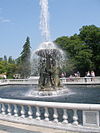Detroit International Riverfront

The Detroit International Riverfront is a
History
The Detroit Riverfront Conservancy, incorporated as a
Features
The area contains the

Belle Isle Park
Aretha Franklin Amphitheater
| Aretha Franklin Amphitheater | |
|---|---|
 Aretha Franklin Amphitheater | |
 | |
| Type | Municipal |
| Location | 2600 Atwater St., Detroit |
| Coordinates | 42°20′1.89″N 83°1′17.14″W / 42.3338583°N 83.0214278°W |
The Aretha Franklin Amphitheater, formerly known as Chene Park, is located on the near east side of
The park was originally named for Charles Chene, a French immigrant who owned a strip of land along the shores of the Detroit River that extended into what is now just east of downtown.[5] On September 4, 2018, Detroit City Council unanimously voted to rename Chene Park the Aretha Franklin Amphitheater after the famous singer who died on August 16, 2018. The change took place before the 2019 season.[6][7]

Dequindre Cut Greenway
Dequindre Cut Greenway is a non-motorized trail extending from the
Construction of phase I of the Dequindre Cut Greenway, extending from the River one mile (1.6 km) north to Gratiot Avenue, is complete. Funded by MDOT's Transportation Enhancement Program and the Community Foundation of Southeast Michigan, this portion of the greenway sets the template for future phases and includes a 20-foot (6.1 m) bituminous path; access ramps for bicyclists, pedestrians and emergency vehicles; landscaping; lighting; signage and security cameras. The first phase of the trail officially opened May 14, 2009 with an opening ribbon-cutting ceremony at the Woodbridge Street entrance of the greenway between Orleans Street and St. Aubin Street.
The Dequindre Cut Greenway phase II North project begins at the northern terminus of the phase I at
The Dequindre Cut is noted for the high quality graffiti covering the walls of the corridor. The Riverfront Conservancy which operates the greenway will permit current and future painted art work to remain as long as it is not deemed offensive. The trail is one of the city's few public art parks and is a major attraction for urban photographers.[1]
GM Plaza and Promenade
The Renaissance Center, nicknamed the RenCen, is a group of seven interconnected skyscrapers in Detroit, Michigan, and the tallest building in Michigan since 1977. Located on the Detroit International Riverfront, the entire Renaissance Center complex is owned by General Motors. The central tower is occupied by the Detroit Marriott at the Renaissance Center, the tallest all-hotel skyscraper in the Western Hemisphere with the largest rooftop restaurant, called Coach Insignia. The complex contains many restaurants, a variety of shops, and the vehicle display known as GM World. GM donated its portion of the plaza and promenade to the Riverfront Conservancy upon completion. A cruise-ship passenger terminal stands on Hart Plaza, adjacent to the Renaissance Center. In 2003,
Work continued in and around the complex until 2005. The Renaissance Center totals 5.5 million square feet (511,000 m2), making it one of the world's largest office complexes.

Hart Plaza and the Dock of Detroit
The 14-acre (5.7 ha) plaza, which is named for the late U.S. Senator
River Place
The historic
River Walk
| River Walk | |
|---|---|
 GM Plaza and Promenade on the riverfront at the Renaissance Center | |
| Location | Detroit |
| Established | 2007 |
| Designation | Municipal |
| Trail map | |
 | |
The Detroit International Riverfront includes a 5+1⁄2-mile (8.8 km) promenade called the River Walk which is to extend from the
The east riverfront promenade connects an area known as Rivertown. It extends along the east riverfront area from the
The first 3.5 miles (5.6 km) of continuous riverfront promenade and two of the four planned pavilions opened to the public on June 6, 2007. Rivard Plaza located at the foot of Rivard Street features a covered seating, a carousel, concessions and bike rentals. Richard Plaza located in Gabriel Richard Park features covered seating, concessions and a butterfly garden. The River Walk is continuous from Joe Louis Arena to Milliken State Park with unfinished sections between the state park and River Place. From River Place the River Walk is then continuous through Mt Elliott Park to the former site of the Uniroyal Tire factory west of Belle Isle. The west riverfront promenade development is not expected to be completed before 2022. The west riverfront includes the high-rise

William G. Milliken State Park and Harbor
Riverfront activities

Detroit River Days, a five-day festival on the International Riverfront, marked the 2007 opening of the riverfront promenade along the east river leading up to the
Traditionally, several days of events were planned, ending with one of the world's largest fireworks displays,[12] sponsored by Target. In prior years, the fireworks display has been billed as the world's largest. On the Windsor side, there is a midway consisting of carnival rides and concessions during the festival. The Midway operates as stand-alone attraction at the end of June, beginning of July.
The Detroit Electronic Music Festival (DEMF) is an electronic dance music showcase held in Hart Plaza each Memorial Day weekend since 2000. In subsequent years, the similarly themed festivals Movement (2003–2004), Fuse-In (2005) and currently, Movement: Detroit's Electronic Music Festival (2006–present) continue the DEMF's traditions, with each name change reflecting shifts in festival management. All of these festivals featured performances by musicians and DJs, and emphasized the progressive qualities of the culture surrounding electronic music.
The International Riverfront is host to part of the Detroit International Jazz Festival held in Hart Plaza each Labor Day weekend. Hart Plaza is also the traditional location of rallies to celebrate championships won by Detroit's major sports teams. Both Detroit and Windsor have hosted the Red Bull Air Race World Championship on the International Riverfront.
Photo gallery
-
Riverfront circa 1901
-
View from Caesars Windsor casino resort overlooking Detroit
-
Looking upriver to Belle Isle State Park
-
Rivard Plaza includes a Merry-Go-Round.
-
Dry Dock Complex historic redevelopment
-
Skyline along the International Riverfront
-
Renaissance Center
-
Detroit's skyline as seen from Belle Isle
See also
Notes
- ^ a b c d e f g "Detroit Riverfront Conservancy". Detroitriverfront.org. Retrieved 2013-12-03.
- ^ "Best Riverwalk Winners (2021) | USA TODAY 10Best". 10Best. Retrieved 2021-02-26.
- ^ "Best Riverwalk Winners (2022) | USA TODAY 10Best". 10Best. Retrieved 2022-10-30.
- ^ Detroit News Editorial (December 13, 2002). At Last, Sensible Dream for Detroit's Riverfront. Detroit News.
- ^ "Chene Park Amphitheatre". MusicWiki Detroit. Retrieved 2018-08-31.
- ^ Ferretti, Christine (September 4, 2018). "Detroit council OKs renaming Chene Park after Aretha Franklin". The Detroit News. Retrieved October 5, 2018.
- ^ Riley, Rochelle (September 4, 2018). "Aretha Franklin's name on Chane Park Ok'd by city council". Detroit Free Press. Retrieved October 5, 2018.
- ^ AIA Detroit Urban Priorities Committee, (1-10-2006). Top 10 Detroit Interiors, Model D Media.
- ^ Detroit Wayne County Port Authority Breaks Ground on $11.25 Million Public Dock and Terminal. (June 21, 2004). PRNewswire. Retrieved on January 20, 2008.
- ^ "Hart Plaza | Detroit Historical Society". detroithistorical.org. Retrieved 2020-10-26.
- ^ "Hart Plaza | Detroit Riverfront Conservancy". detroitriverfront.org. Retrieved 2020-10-26.
- ^ Mink, Randy, and Karen Mink (July 2001). Detroit Turns 300 - Detroit 300 Festival. Travel America, World Publishing Co., Gale Group.
References and further reading
- Cantor, George (2005). Detroit: An Insiders Guide to Michigan. University of Michigan Press. ISBN 0472030922.
- Hill, Eric J. and John Gallagher (2002). AIA Detroit: The American Institute of Architects Guide to Detroit Architecture. Wayne State University Press. ISBN 0-8143-3120-3.
- Rodriguez, Michael and Thomas Featherstone (2003). Detroit's Belle Isle Island Park Gem (Images of America). Arcadia Publishing. ISBN 0-7385-2315-1.
- Sobocinski, Melanie Grunow (2005). Detroit and Rome: building on the past. Regents of the University of Michigan. ISBN 0933691092.
External links
- Canadian Heritage River Systems
- Detroit Riverfront Conservancy
- Detroit Wayne County Port Authority
- Downtown Detroit Partnership
- Great Lakes Cruising Coalition
- Photography-plus.com
- Riverfront Towers
- Tri-Centennial State Park official website
- Sea Grant Michigan
- Video review of the Riverfront with on-site footage
- Eastern Market Detroit Archived 2009-06-06 at the Wayback Machine
- Model D Transformations













